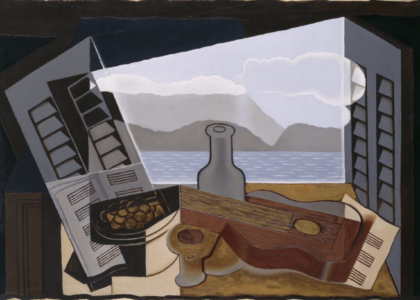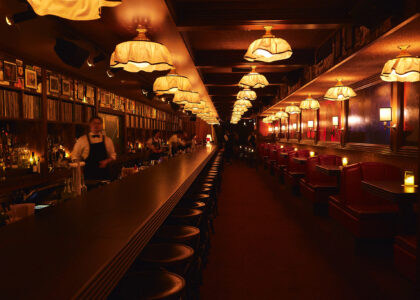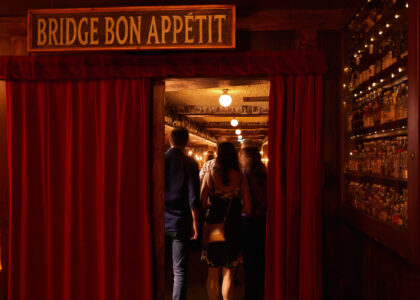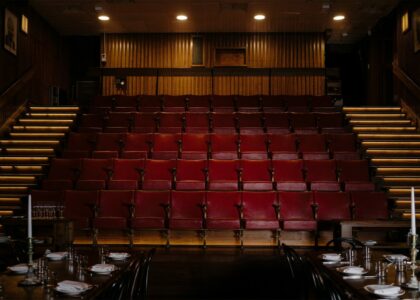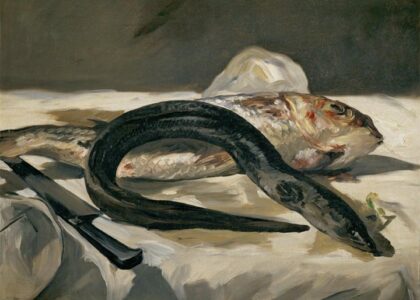There’s a popular theory that a person is either an Indoor Dog (comfort-loving, sedentary, clean and warm), or an Outdoor Dog (elemental, unconcerned by creature comforts or dirt). Annie Smithers, chef-owner of farm-to-table restaurant Du Fermier, is most definitely an Outdoor Dog.
Happiest amongst plants and surrounded by animals, Smithers and her wife Susan have created a sanctuary for themselves, a short drive from the sleepy Victorian town of Trentham where Du Fermier is located. Together, they grow produce for the restaurant, and care for a swathe of ailing, ageing and rare-breed creatures. Welcome to Babbington Park, watch the wombat holes and mind the geese.
It’s here at their Federation homestead, 770 metres above sea level at the tail end of the Divide and shaded by a 500 year old Manna gum, that Smithers has shaped her life. A property that’s so interlinked with her restaurant, it’s hard to define where one ends and the other begins.
“I love how long some of these things take. It teaches you this amazing respect for a thing.”
“Come in,” she says as a goose waddles past, pecking at something delicious in the soil. “This is our funny little world.” The goose, who somehow survived hatching from a squashed egg, goes by the name Princess Pancake Party Pants, a nod to both her near death experience and her feather pantaloons.
“Here’s our sick rooster”, says Smithers pointing to a huge ginger Orpington, valiantly crossing the yard in gale-force winds like a sea captain navigating the Atlantic.
There are animals everywhere. Rare breeds of ducks, cows, goats, geese and hens; a hatchery in the shed filled with ducklings; old dogs; a trio of British shorthair cats that hang out in the old laundry alongside countless trays of curing garlic, and sacks of mohair and wool. “Susan’s a vegan,” says Smithers, “so all the animals on the property are either pets or used for purpose.”
Not one for throwing things out, up until recently, she kept the bones from her deceased cat Sam on the kitchen table until Susan made her put them in a display case. A Wesleyan church, dumped on the property, is being refurbished for cooking classes by Susan’s ex-husband Greg, who works on the upkeep of all the buildings on the property, including the barn, homestead and boathouse. “Greg’s an old-school carpenter. He’s slowly rebuilding the whole property. We’re a beautiful, extended modern family.”
It never fails to strike me how expensive it is, energy-wise, to live a quiet life. It requires constant motion, from the moment the farm wakes and the restaurant lights go on, to the moment the last chook is roosting and the last dish is washed. It’s not furious, just that it’s a matter of consistency and no pauses. “We are living the dream,” she says. “It’s not always fun. When you come home, one of the chickens hasn’t gone to bed and it’s pissing with rain, you’ve got to climb a ladder [to the chicken coop to put it to bed].”
“Restaurants are so beautiful on so many levels.”
Smithers employees two full time gardeners on the property. Depending on the time of year, they grow cucumbers, bush beans, artichokes, asparagus, rhubarb, cauliflower, red cabbages, romanesco, red and white kohlrabi, Seville oranges, heritage apples, every berry under the sun… the list goes on. “If I wanted to give up the restaurant and just grow things for the rest of my life, I know I could support us,” she says. “It’d be slim, though.”
“We plant very much on the biodynamic calendar without being biodynamic farmers,” she says, picking up a cluster of gnarly, lumpy-looking tomatoes that grow off each other like tiny limbs. (The idea is when you’re travelling, you just have a couple of these in your bag, and you pop them in your mouth as you go. They’re their own packaging.)
“I just get so excited by plants,” she says, digging up a potato to show me. “[This] is potato country. [We have] Dutch cream, Kramer Nicola, russet burbank… and these are la ratte, [celebrated French chef] Joel Robuchon’s mashing potatoes.”
She makes her own cornichons (“we pick them daily because they grow like weeds. And they’re such arseholes because they’re prickly”) and enjoys a love/hate relationship with eggplants. “They are the most vile plants because of the thorns.”
Annie Smithers loves a challenging plant. Her parsnips have been in the ground for nine months. “I love how long some of these things take. It teaches you this amazing respect for a thing. “I mean, how can you not love food when you are surrounded by it?”
So how does Annie Smithers plan a menu? “The proteins are set,” she says. “First week of the month is duck. Second is lamb, third is pork. Fourth is beef and then roosters fill in the gaps. So I start with the protein and then I work backwards. I think that logistical head that a lot of cooks have helps with the garden.”
It doesn’t always work out as planned. Nature is always going to have its say and things have a habit of going wrong whenever they can. “Stuff fails,” says Smithers. “I mean, how do you control the uncontrollable?”
Still, you can manage a few mitigating factors. She keeps the restaurant hours to a manageable four lunches a week for 24 people each service. Not just for her, but for her floor staff. She did the maths on that too.
“The mental health of the waiting staff is really pushed by having to absorb all the things that come out – and from – customers. You know, the navigation that they have to do on a day to day basis of how to nurture all those little souls is quite extraordinary.”
“Now they’re telling people what I’ve always believed – that if you work over gas long enough, it doesn’t give you oxygen to your brain. And that’s why all cooks are mad.”
To ease the strain both for herself and front-of-house, the chef worked out how many days they were going to operate, and how many people she could cook for the standard she wanted to represent.
[Essentially] “this is the amount of money that we need to run our life,” says Smithers. “It’s what we need to run the restaurant and the farm, to employ the people that we do on adequate wages for an adequate day’s work. We’re very much focused on not taking more than our fair share.”
24 seats, one chef, no other kitchen staff, two people on the floor and a booking system that opens for the month, two months in advance: those aren’t numbers for the faint of heart. And it always comes down to numbers with Annie Smithers. Even the garden originally started out as a mathematical experiment which has developed into a restaurant fueled by what she grows out on her property.
Du Fermier is a small, but thoughtful space. Well-trodden, paint-spattered floorboards, bentwood-style chairs, well-elbowed tables are dressed simply with raw linen napery, fresh cut flowers and a little photo postcard of Annie Smithers in her kitchen looking miserable.
Take away all the bells and whistles of any restaurant and what are you left with, essentially? Four walls, chairs to sit on, tables to eat off, people to serve and someone to cook it. And that’s what you get here. “I want to renovate the kitchen, because it’s really small,” says Smithers. “I’ve been in there for 10 years already, walking around corners. And I’d really like not to. But I just keep thinking, ‘why would I spend $200,000?’ What’s the point?”
Such is the allure of this tiny Trentham restaurant, that her customers are easy with the system she’s set up. If anything, it adds to the experience. “And you know what? People come back. That’s the greatest gift that any customer can give you,” says Smithers. “They choose to come and eat at my place. The toilets are outside and the floorboards are pretty shabby, but I don’t think we want to change it.”
Bookshelves line the wall filled with all the right stuff. Richard Olney’s Good Cook series, and the Cuisine of Paul Bocuse are bookended with a bottle of Lillet blanc. Closer to home, Stephanie Alexander’s Kitchen Garden Companion and Damien Pignolet’s Salades, held in place by a bottle of sweet vermouth. The shelves go on, and so does the wine.
The lack of scene is most striking of all. Perhaps it’s the stripped back nature of the place, but a more honest restaurant experience you are unlikely to find, with very little signage and zero fanfare. It’s actually peaceful. Possibly because it’s in one of the sleepiest towns this side of the Victorian border, but it’s a naturally serene place to eat, too. Sincere, unselfconsciousness, comfortable, restorative.
“Restaurants are so beautiful on so many levels,” says Smithers. “Sometimes I just sit there, on a Wednesday afternoon, doing the books. And you look at the chairs and the tables, and you look at the glassware, cutlery and crockery, and I think ‘oh my god, I own all of this shit.’”
The model for Du Fermier is a French-style farm-to table experience. Anything she doesn’t grow/rear herself is sourced from the area. “My prime purpose in life is ‘I have you for three hours of your life. You sit in my space. My objective is to make you feel loved and nurtured for those three hours. That’s all it is.”
The first thing Smithers does every day once she gets to the restaurant is take everything off the benches, and make the bread. “You immerse your hands in this dough that is comforting and just warm and alive,” she says. “And the day starts.”
Working alone saves on costs and allows for total control, sure, but it has its drawbacks. On my visit, Smithers had only just recovered from a run in with a tray of hot lamb fat, forcing her to spend Saturday lunch service with her foot in a bucket of iced water. And because she doesn’t have a kitchen hand, she had to wash all the dishes peg-legged and bucket-bound. “I’ve always been a bit chaotic,” she says. “But it’s worth it. That’s the adrenaline rush, and that’s the aphrodisiac of it.”
Today, Smithers’ bread lands on the table with a dish of fresh-churned butter, followed by house-smoked Victorian trout belly, draped over a pikelet spread with creme fraiche, hidden under a thicket of finely shaved baby cucumbers.
She used the same smoker to make the lardons that punctuate a classic frisee salad. The lettuce (“one of my pet subjects”) is grown out at the property, the smoky little fat batons made from a mate’s pig, croutons from yesterday’s baguettes all topped with a free-range pullet egg which dresses the leaves with its sweet, rich burnt orange yolk.
The chef has mixed feelings about using the smoker at all, mainly because the last time she did, she blew herself up.
Tired, and not paying quite as much attention as the situation warranted, there was a malfunction. The next thing she knew her hair was standing up like Henry Spencer in Eraserhead, she was covered in black soot, and because she was wearing her specs at the time, she had huge white rings around her eyes. “It was very traumatic but I was fine,” says Smithers.
Telling her blowing herself up was worth it for the delicious results feels somehow cruel, so I keep it to myself.
“There’s an enormous freedom in being a small owner-operated restaurant. You build it and see if they come. And if they don’t, well, what’s next?”
So how does a person make a decision to run a restaurant this way? It takes a certain type of person to make a life growing and cooking in the country and it’s rarer on the Australian cooking scene than it should be. She did the bulk of her apprenticeship under Australian restaurant and kitchen gardening doyenne, Stephanie Alexander at her groundbreaking restaurant, Stephanie’s (“I’m grounded in that classical French restaurant food. That’s my skill set”) which ran from the 70s through to the 90s.
She did a stint with Geoff Lindsay at Melbourne mod-Asian restaurant Pearl, famous for his high voltage approach to fine(ish) dining, but it was short-lived. The wok-burners and kitchen’s turbo-partying freaked her out. Far more comfortable in the country (Outdoor Dog), she then found a place at Lake House under Alla Wolf Tasker.
“Our industry seems to beckon fragile people,” says Smithers. “I think there’s a creative nature to what we all do. We know that people who are more creative are often a little more delicate. And now they’re telling people what I’ve always believed – that if you work over gas long enough, it doesn’t give you oxygen to your brain. And that’s why all cooks are mad.”
For Smithers, cooking is about a sense of place. Her connection to her surroundings and producing on a small scale is what makes her food sing. But accepting that wasn’t a straightforward process. “Each person has their own narrative as to how they want their restaurant to run,” she says. “But sometimes it’s a struggle to get to that point where you trust your own narrative.”
There was a point where it clicked for Smithers. That no amount of feeling like her restaurant wasn’t stacking up to the fast-changing pace of Melbourne restaurateurs with far deeper hip pockets than hers was going to improve what she was doing in her own venue. So she made a choice to let go and just cook. “As a small restaurateur, I started with nothing. I think when you start with nothing, you’ve got nothing to lose. So you have the capacity to take greater risk. But when you’re in this cycle of having backers and other people’s money, there’s a need to perform, and to reimburse and to make good on promises,” says Smithers.
“I don’t need to muck around with the vegetables because they speak for themselves. And the meat and the poultry and all the things I use. It’s all got a voice,” she says. “Because it’s all small and carefully and regeneratively produced, it has flavours that people have forgotten about. Everything’s got the touch of my little paws on it, and it’s cared for and loved through the process.”
“I think as a restaurateur and as a cook, I like to work on something that is a little bit more meaningful. So therefore, the garden and therefore addressing the mathematics of the garden to the restaurant, and now the restaurant is dictated to by the garden, it’s a full circle.”
There’s power in being able to make and grow what you need, and then share that skill. It’s what keeps diners coming back, and ultimately what makes someone like Annie Smithers tick. “You know, if I want to make puff pastry, I can make puff pastry. If I want to make bacon, I can make bacon. If I want to break up a whole lamb, I can break up a whole lamb. Am I a master of any of them? I don’t know. It’s just cooking.”
Du Fermier; 42 High St, Trentham VIC 3458. 03 5424 1634. anniesmithers.com.au

